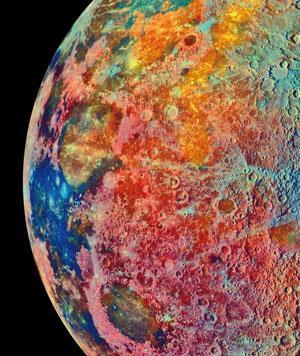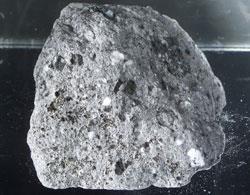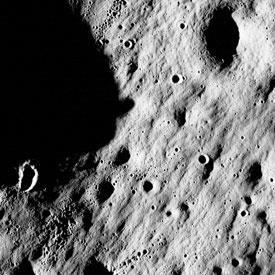NASA's Apollo missions answered many questions about the Moon - and as NASA unveils plans to return, lunar chemistry will again play a prominent role, says Richard Corfield
NASA’s Apollo missions answered many questions about the Moon - and as NASA unveils plans to return, lunar chemistry will again play a prominent role, says Richard Corfield
Everybody remembers the historic first lunar landing of Apollo 11 in July 1969. It is when humanity took its first faltering footsteps away from the planet where we evolved. But as Neil Armstrong and Buzz Aldrin stood and waited for the hypergolic motor under the lunar module, Eagle, to ignite that would take them back to the command module, Columbia, they knew, as did the engineers back at Houston, that they were merely the vanguard and that the real work of the Apollo projects was only just beginning.
There was nothing haphazard about the arrangement of the Apollo landings. Each one built incrementally upon the success of the one before. Even the near disaster of Apollo 13 could not put this inexorable progress off its stride. The six successful lunar missions can be grouped into two categories: 11, 12 and 14 - the so-called ’H’ missions; and 15, 16 and 17 - the ’J’ missions. These latter missions had science - particularly the chemistry and geology of the Moon - at their heart.
The face of the Moon

Since the dawn of civilisation, the light and dark areas visible on the surface of Moon have made people wonder about its structure. But it was Galileo who initiated the proper scientific study of the Moon. In November of 1609 he started one of his earliest projects with his new telescope, a detailed map of the near side of the Moon. Galileo’s observations immediately showed that the Moon’s surface was heavily cratered with mountains and valleys. Dark patches on the Moon clearly visible to the naked eye were called ’maria’, the Latin for ’seas’. Famous examples are Mare Tranquillitatis, the Sea of Tranquillity, and Oceanus Procellarum, the Ocean of Storms. These dark areas once thought to be seas are now known to be the Moon’s lowlands, and the lighter areas surrounding them - the ’terrae’ - are the lunar highlands.
In 1958, three years before President John F Kennedy would commit the US to landing a man on the Moon by 1970, Nobel laureate and Manhattan project veteran Harold Urey approached NASA associate administrator Homer Newell and suggested the scientific study of the Moon should be a major focus of the newly minted US space effort.
Urey believed that the Moon’s craters had been formed solely by meteorite bombardment (the so-called ’cold-Moon’ theory). This was in contrast to the competing theory (spearheaded by Gerard Kuiper of Kuiper Belt fame) that the Moon, like its neighbour Earth, had once been intensely volcanically active. These ’hot-Mooners’ believed that an ancient period of intense volcanism, now long ceased, had turned the Moon into an overcooked cinder, forming the Moon’s craters in the process.
In fact the two competing theories could be tested relatively easily. All that was necessary was to go to the Moon and perform some chemistry.
William Hartmann was a young cosmochemist at the time of the first Moon landings. For much of his career he has been interested in the central questions that surround the Moon - what are the maria and the highlands, how old are they, how was the Moon formed, and perhaps most importantly, what can it still tell us.
Hartmann is clear that all of the Apollo missions were scientifically important even if, as he says, the first two missions were really to establish the engineering and the safety of the programme. ’They gave us access to the lava plains and the dating of the lava plains. In fact, most of the rocks that they picked up there were related to the emplacement of those lava plains.’

Urey too knew that an early trip to the lava plains would prove his theory one way or the other. And so it proved. As Armstrong walked on the Moon he spotted something that looked like a vesicular rock - a rock likely to have been formed by volcanism. Armstrong was unsure however and Urey was relieved when Armstrong changed his mind. However, the first batch of samples returned from the Moon were delivered to the lunar receiving laboratory later in July 1969 and then investigations proceeded so quickly that by September 1969 NASA was able to announce the preliminary findings, and they held bad news for Urey. The rocks returned by Apollo 11 were unequivocally basalts, a rock well known to be formed volcanically. The cold Moon theory was disproved.
Farouk El-Baz was a key player in the geology of the Apollo missions and arguably the man most directly responsible for selecting the landing sites. He too is in no doubt as to the importance of the science of Apollo. ’It was Apollo 11 that answered that question [the hot Moon/cold Moon debate] early on. As soon as we got the samples from Apollo 11 and found out that it was basalt there was no question that it was from volcanism.’ He recalls wryly that Urey was not at all happy with this turn of events. ’Harold still could not accept it though. He thought that perhaps the force [of impacting meteorites] had been so severe that they had penetrated the crust and released lava from within the Moon [thereby forming the maria]. So he did not give up right away. But to us, as geologists, it was confirmation that it was volcanic basalt, and we know how basalt forms.’

The birth of the Moon
Another question that perplexed the scientists behind the Apollo programme was: How, exactly, did the Moon form? Before Apollo several competing suggestions were in circulation. Had the Moon been formed when a chunk of the Earth broke free through centrifugal forces - leaving the Pacific basin behind as the scar of its amputation? Was the Moon a body from elsewhere in the solar system that had been captured by the Earth’s gravitation? Had the Earth and the Moon formed at the same time from the accretionary disk of dust and gases circling the young Sun during the birth of the solar system? The problem was that none of these ideas could explain why the Earth is the only one of the inner, terrestrial planets to have such a large satellite. Venus - of similar size to the Earth - has none, while Mars’ two satellites, Phobos and Deimos, are both very tiny.

In 1970s George Wetherill of the Carnegie Institution showed, using a multivariate technique only then becoming available via the new generation of supercomputers, that hundreds of bodies with roughly the same mass as the Moon could form one or two Earth-mass planets (ie Venus and Earth), and perhaps a few smaller rocky planets (Mercury and Mars), orbiting at their observed distances from the Sun.
This finding stimulated Hartmann and his colleague Don Davis to suggest the Moon’s formation almost certainly involved one or two of these planets colliding with the primordial Earth while it was still forming from the material of the accretionary disk. If such a giant impact occurred off-centre, it would fire molten mantle material into orbit around the Earth. They hypothesised that this debris later coalesced into the Moon.
Hartmann, a meteorite crater enthusiast, recalls, ’I had been thinking a lot about what these objects were which hit the Moon. How big do they get? Also, it was known that the Moon had a lower mean density than the Earth because it had no iron core. It occurred to me that if a big enough object hit the Earth in the past it could have blown off the mantle material - assuming that the Earth’s core had already formed - and that would explain why the Moon has this lower mean density; it has no material from the Earth’s core.’
But, at first, the geochemical data seemed stacked against his idea and his natural caution prevented him from publishing. Then came the good news, says Hartmann. ’The big change came when we looked at the ratio of oxygen isotopes on the Moon. They were identical to those of the Earth, whereas every other sample that we have from every other part of the solar system is very different to those of the Earth. And that data was not just from the samples returned by the Apollo missions but was also supported by the three Russian robot lander missions that had returned samples to Earth as well.’
The hypothesis that the Moon formed by a giant impact early on in solar system history is now the leading theory for formation of our nearest neighbour in the solar system.

The future of the Moon
What then of the future for the science of the Moon? Does it have one? The answer is an unequivocal yes. NASA’s Lunar Reconnaissance Orbiter (LRO) shattered the surly bonds of Earth at Pad 41 at the Cape Canaveral Air force base on 18 June this year and arrived in orbit on 22 June. After entering its commissioning orbit, it will take four to six weeks to shake down into its stable polar orbit which will vary from an epilune (low point) of only 30km over the south pole to a perilune (high point) of about 260km over the north, says Rich Vondrak, LRO project scientist and director of solar system exploration at NASA’s Goddard Space Flight Centre in Maryland. It is impossible to understate the importance of the mission because it is the first step on our route back to the Moon.
’We have three main purposes for this mission,’ Vondrak says. ’The first one is to create new maps of the Moon and identify safe landing sites for future astronauts. The second is to search for resources, and the resources we expect to be looking for are sunlight in permanently illuminated regions and volatiles that may be trapped in permanently shadowed regions. The third is to measure some elements of the space radiation environment that are not well understood now.’ Talking to Vondrak there is no doubt that this is first step in NASA’s mission to build a permanent bridgehead on the Moon. A key is looking for water ice in the shadowed regions of the poles. Why? ’We are talking about using lunar resources. The idea is to go there and capture some of the ice for two quite specific purposes - human consumption and as rocket propellant.’

Hartmann agrees that finding volatiles on the Moon would be a major step forward but is also excited about the possibility of using the LRO’s high resolution cameras to image small craters. ’It will begin to detect new small craters as they are formed and once you have calibrated the rate at which craters form it will be possible to use that number to measure the age of small surface features on the Moon and elsewhere. Imagine how important it would be to date a glacial deposit on Mars!’
There is one man for whom the lure of the Moon has never faded. Apollo 17 crew member Harrison ’Jack’ Schmitt was the penultimate astronaut to walk on the Moon and he wants to go back. In his book Return to the Moon Schmitt outlines his arguments why. The main one is that he believes that the Moon is a source of limitless, clean energy. Schmitt, for many years, has been a proponent of the lunar mining of helium-3, a rare light isotope of helium that is not found on Earth because it is deflected by our planet’s own magnetic field but which is to be found in the lunar soil. The advantage of helium-3 is that it fuses with deuterium in a much cleaner reaction than the more conventional deuterium-tritium fusion reaction. This so-called ’first generation’ fusion produces high-energy neutrons, which make the decommissioning of the tokomak containment vessels where the reaction occurs very costly. Second generation fusion, for example helium-3 with deuterium, produces one proton, which can be readily channelled by electrical and magnetic fields, and one atom of helium-4, otherwise known as balloon gas. Schmitt points out that progress is being made, albeit slowly, at the University of Wisconsin’s Fusion Technology Institute and that the power output from second generation fusion reactions is being pushed inexorably higher. However, finding investment continues to be challenging. To make the project commercially viable Schmitt estimates that the smallest unit would have to be capable of producing 100 megawatts.
As we revisit the epic events of forty years ago it is worth recalling that the LRO’s camera can image 50cm from 50km. This means that it will be able to image the descent stages of the lunar modules left behind on the surface of the Moon, the blast craters created by the lander’s engines, as well as the ALSEP experiment packages placed there by the astronauts. No camera has ever before had the resolution to do this. It will be awesome to see again the engineering legacy of Apollo.
As Farouk El-Baz says, ’I shall certainly feel a great deal of happiness and joy when I see them again - because I know what we got out of them.’
Richard Corfield is a science writer based in Oxford, UK






No comments yet